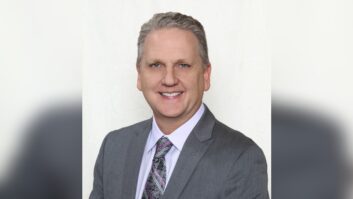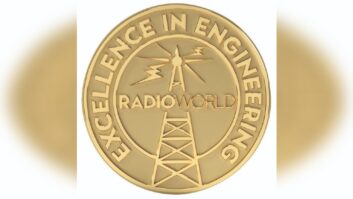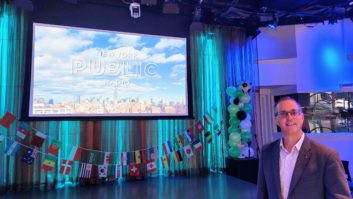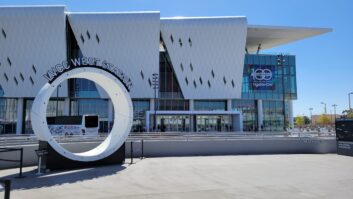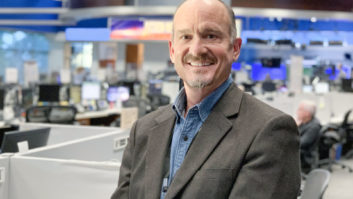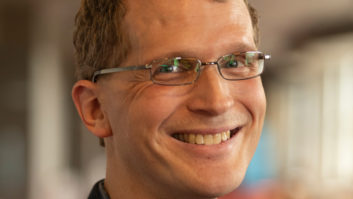Michael Cooney is the recipient of the 2016–17 Radio World Excellence in Engineering Award.
Recipients represent the highest ideals of the U.S. radio broadcast engineering profession and reflect those ideals through contributions to the industry. Cooney is the 13th person we have honored since introducing the award in 2004.
Cooney, 53, is chief technology officer and vice president of engineering of Beasley Broadcast Group, a publicly traded, family-led broadcaster that continues to grow in prominence among U.S. commercial radio groups. He also chairs the National Association of Broadcasters’ Radio Technology Committee, where many of the industry’s leading technologists confer about radio’s future. He serves on NAB’s separate Automotive Digital Dashboard Committee and is also a member of the Technical Standards Committee for the Broadcast Traffic Consortium, of which Beasley is a founding member.
When you talk with Mike Cooney, you get the sense not only of high competence but of directness glimmering from behind a quiet, even-keeled personality (though he insists he isn’t always so mild in the office). You aren’t surprised to learn that he comes from the upper Midwest, a rural South Dakota town of about 350 people — the kind of place where folks left their keys in their vehicles and where even today they don’t lock their doors. His dad was a postmaster, his mom a legal assistant. It was a great place to grow up, but not one with a lot of career opportunities unless you wanted to work the land, as most of his friends did.
Cooney remembers being interested in radio as a child, but his entry into the industry was not exactly planned. He attended Lake Area Technical Institute in Watertown, S.D., studying industrial electronics; and upon graduation, while looking for work, he happened to learn of an opening at South Dakota Public Television and Radio, part of the South Dakota State University. He took a job as assistant chief engineer and microwave technician, and “I just grew from there; I loved doing it.”
This led to a position as a corporate chief engineer for Radio One Broadcasting — not the company we know today with a similar name but a small entity based in Lincoln, Neb. Small, but growing; Cooney helped it expand from two stations to a couple of dozen within just a few years at a time before fast consolidation became common.
For six years in the 1990s, he performed project management and design work for a military subcontractor, a role that included designing and installing radio and TV facilities worldwide, including high-power radio jobs in the Philippines. He also worked for an AV integrator and ran his own broadcast engineering contract business.
Then he was recruited to work for Entercom, where for eight years he managed the daily activities of 10 to 15 staff members in the engineering, IT and web departments. He led multimillion-dollar capital projects and was the principal design engineer and construction manager for one of the country’s largest broadcast facilities, a 45,000-square-foot facility in Kansas City serving nine Entercom stations.
FAMILY ATMOSPHERE
Beasley Broadcast Group came calling in 2007. Now, almost a decade later, Cooney manages engineering and IT and close to 100 technical staff in those departments. He plans Beasley’s capital and engineering budgets, leads and designs its large studio and transmitter facility projects, and manages its corporate tower rental activities.
At Beasley he found a “family-type atmosphere … very open-door.” He appreciates that he can walk into the office of CEO Caroline Beasley at any time and that he has had the opportunity to sit and talk for hours with patriarch George Beasley. “Corporate here is very much different than a lot of corporate operations I’ve seen,” he told me. “It’s very much to support the markets and support the radio stations.”
Much of Cooney’s work in the past two years has involved FM translators to benefit the company’s AM holdings. Beasley has almost two dozen translators; Cooney negotiated, purchased and engineered most of them. The company, he said, decided that “if we’re going to keep our AMs, and we’re going to keep them profitable, we need to expand them into FM wherever possible. We need to either buy FM signals in the markets they’re with, or we need to buy a translator for them if possible. … Also, when it comes time, if you do want to sell the AM, they’re vastly more valuable if you can tie a translator with it.”
Lately, though, much of his attention has turned to Beasley’s acquisition of Greater Media Inc., on which Cooney did months of due diligence work and which netted Beasley 18 more primary signals. The number of stations under his oversight has blossomed to 69, not counting digital multicasts and translators; the growth will bring changes to the company infrastructure, including stations being spun off in Charlotte, and some facilities being consolidated in Boston and Philadelphia/Wilmington.
The entire process makes Cooney even more aware of what he describes as a real shortage of engineers — “If you’re a good engineer, you’re probably working.” And Beasley, in fact, is on the lookout to fill several positions. However, the acquisition also meant that Milford Smith, Greater Media’s longtime VP of radio engineering and himself a recipient of Radio World’s Excellence in Engineering Award, saw his position eliminated, though he continues to do contract and consulting work for Beasley. Cooney considers him a friend: “Smitty doesn’t have an enemy in the world.”
What’s next? Talking to Cooney, you get the sense Beasley may not be done acquiring.
“Caroline and I both believe very much that our future is digital; and if anything, that’s one of our biggest priorities in the future, developing a digital strategy both from third-party products, streaming, websites, podcasting, all those other products, the non-traditional type revenue.”
With Beasley showing itself willing to grow through acquisition, perhaps it will acquire a digital company of some kind. “We’re looking at either developing and building our own infrastructure or buying another company. That’s probably our biggest priority.”
ALL-DIGITAL FM?
The company’s interest in digital includes over-the-air broadcasting, and Beasley is an active HD Radio participant. But Caroline Beasley and Mike Cooney are now thinking beyond hybrid digital FM to a more dramatic future: the desirability of a mandate for the industry to convert the FM band to all-digital broadcasting.
“She thinks that we need to be digital, and she wants me to push the conversion of FM to all-digital in the future,” Cooney said. He acknowledges that this is a “volatile” idea that may scare some people. However, “If TV hadn’t made it a mandate, we would have never had digital television. There are some real advantages to an all-digital FM signal in the future, including additional data for things like the Broadcast Traffic Consortium and others. There are other services that we could potentially make revenue off with the data.”
The ability to make such a conversion someday has always been one of the fundamental selling points of the HD Radio IBOC platform. But of course it could not be accomplished quickly or easily, and would likely be contentious. The process would require the backing of a majority of broadcasters; creation of a standard, presumably involving the National Radio Systems Committee; and a request to the FCC for a conversion mandate.
“We can do all-digital as we speak,” Cooney said. “The problem is the current radios that we have … will only pick up a portion of the channels. Most people don’t know that that requires a redesign of the FM chip. We’re finally at a point where a lot of digital radios are being manufactured and cars are rolling off the assembly line with them; if we don’t stop that and get the next generation of radio that can handle all-digital, it just puts us further and further behind.”
Cooney thus would support an all-digital FM mandate “so that the manufacturers have to start building these and putting them in cars — so that, even if it is 10 or 15 years from now that we go to all-digital, at least there’s a radio that’ll pick it up at that time.”
SPECTRUM CHALLENGES
More immediately, I wondered how Cooney views the spectrum regulatory landscape.
Beasley has some 20 AM stations. Cooney, who was part of revitalization discussions at the NAB’s Radio Technology Committee, was pleased with the FCC’s translator initiative but feels that other steps so far amount to little more than fluff. He thinks it’s unlikely that the FCC will take truly dramatic action.
“To be blunt, I said, ‘If we wait around for the commission to solve our problems for us, AM will be dead and gone by the time they try to fix it.’ I still believe that. If anything is controversial at all, the FCC won’t act on it. … There’s some low-hanging fruit, some easy ones that everyone agrees on like the ratchet rule type things, [but] the other ones, all the tough ones, there’s not enough agreement. I just think nothing will be done with them, or at least for years.”
What about the separate proposal to create a new Class C4 on the FM dial, which supporters say could help hundreds of Class A FM commercial stations in rural America upgrade their power and coverage? “I’m a little nervous about it because after investing hundreds of thousands of dollars in translators, it could displace some translators. I know there’s been some studies done on that to say that it shouldn’t displace many. Beasley has very few Class A signals, so we don’t benefit from it very much. We have some in New Jersey and in Augusta, Ga. Other than that, we have no Class As.”
But Cooney expresses concern about the overall direction of FM spectrum management in the United States, particularly the FCC’s expansion of the low-power service to allow many more LPFMs.
“I think they were a good idea in principal, but I think we are turning the FM band into what the AM band is now.” He noted that there are now 1,600 LPFM stations, and that in the past two decades, more than 4,000 translators have been added to the FM dial.
“My job more and more every day is dealing with, ‘Who are we interfering with, or who is interfering with us?’ We’ve been very lucky recently. Out of 20-something translators we’ve purchased, we’ve never had a single complaint of interference. I think that goes back to doing really good engineering practice and studies before you decide to buy one or build one. Many of the smaller groups are not doing that.”
But he worries about FM crowding. “If the low-power FMs hadn’t come about, I would have been much more supportive of another class. I don’t want to say that I’m against [a Class C4], because I’m not. I’m just nervous about trying to give everyone more power, and everyone an FM radio station, and what we’re doing to the band.”
PRIORITY: DASHBOARD
Recipients of our award tend to be immersed in the industry’s growth and new projects, and Cooney is no exception.
He chairs the NAB’s Radio Technology Committee, which consists of leading technologists from member companies who advise the association; this puts him in regular contact with his peers at most of the country’s other major commercial broadcasters and means he plays a quiet but important role in helping set the industry’s conversation about technology strategies. He also serves on NAB’s new Automotive Digital Dashboard Committee, which consists mostly of radio CEOs, exploring the industry’s future role in next-generation automotive devices and helping build relationships with carmakers.
He credits the work that’s been done by NextRadio and the former iBiquity Digital for advancing those relationships, but says the rest of radio needs to come along. “We need to embrace that and start working much more closely with them so that we remain in the dashboard where we belong. … In my opinion, that’s our biggest priority right now, the future dashboard.”
I asked him about the growing number of “hybrid radio” ideas that have been put forth, seeking to combine one-way, over-the-air broadcast infrastructure with two-way internet connectivity and all of the data and analytics possibilities it could bring.
He said that Nick Piggott of RadioDNS Hybrid Radio recently addressed a Beasley general managers meeting at the company headquarters in Naples, Fla. “I had him speak because I wanted them to understand hybrid radio better than what they do, and where that’s heading … We are also very supportive of NextRadio. I don’t want them to become competitors.” Cooney expresses excitement about what hybrid radio could be. “If we can come up with a standard that we all support and that makes sense, I think the [NAB] Technology Committee needs to be involved in that.”
He also is a member of the Technical Standards Committee of the Broadcast Traffic Consortium, a coalition of North American radio organizations that formed a terrestrial broadcasting network to distribute local traffic, weather, fuel prices and other content via their analog and digital signals; Beasley was a founding member. Today Cooney finds himself researching whether Beasley can make more revenue leasing HD channels to other broadcasters versus using the data for BTC. “If you had an FM all-digital,” he added, “you could do both pretty easily.”
Accomplished, capable, diligent, no-nonsense — Mike Cooney is well deserving of Radio World’s Excellence in Engineering Award.
HONOR ROLL
Recipients of the Radio World Excellence in Engineering Award represent the highest ideals of the U.S. radio broadcast engineering profession and reflect those ideals through contributions to the industry.
2016 Michael Cooney
2015 David H. Layer
2014 Wayne Pecena
2013 Marty Garrison
2012 Paul Brenner
2011 Barry Thomas
2010 Milford Smith
2009 Gary Kline
2008 Jeff Littlejohn
2007 Clay Freinwald
2006 John Lyons
2005 Mike Starling
2004 Andy Andresen





